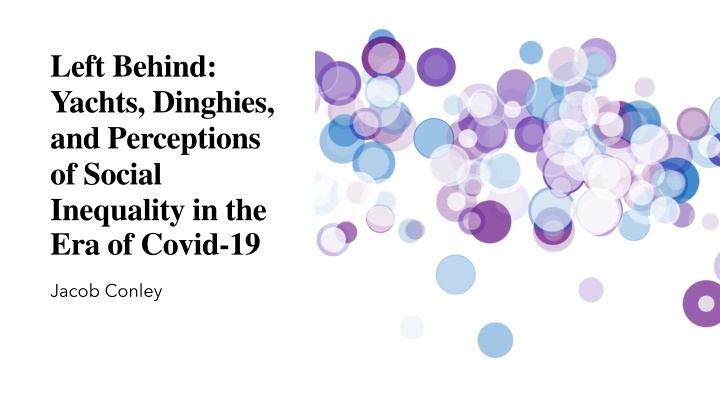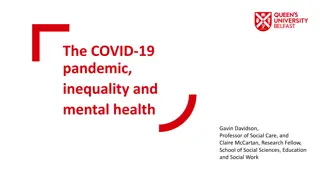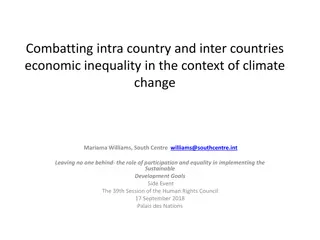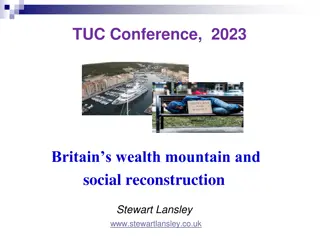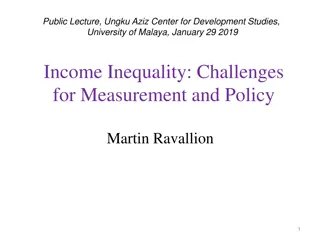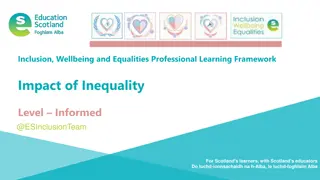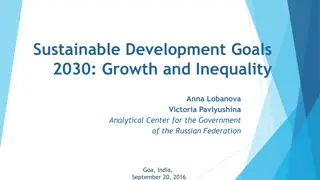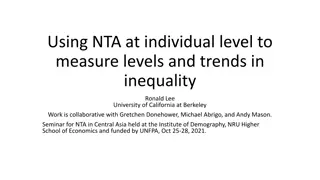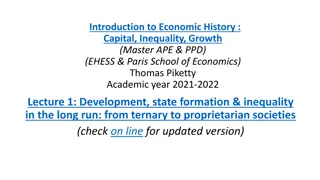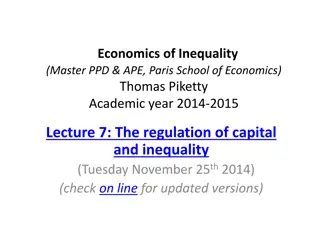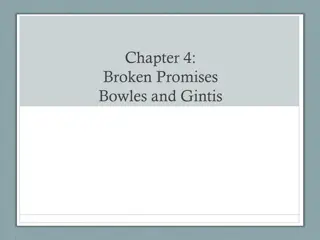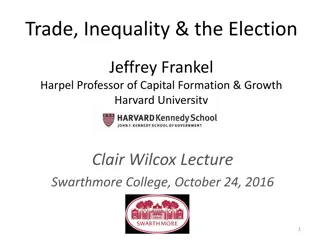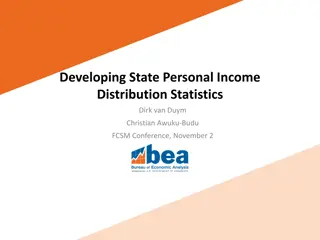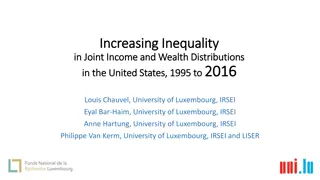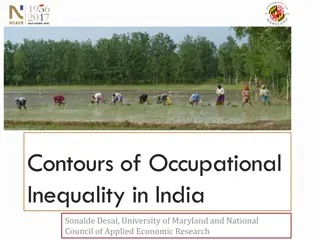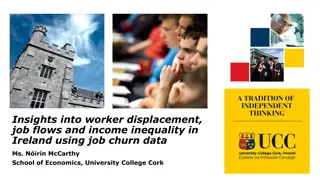Social Inequality and Perceptions in the Covid-19 Era
The article discusses the impact of Covid-19 on social inequality, particularly focusing on how different segments of the working class have been affected. It explores varying perceptions of economic inequality, class conflict, and solidarity among workers during the pandemic. The study also highlights the concept of the "noxious contract" in labor market conditions and presents insights from interviews conducted with gig-based and precarious workers in New York City.
Download Presentation

Please find below an Image/Link to download the presentation.
The content on the website is provided AS IS for your information and personal use only. It may not be sold, licensed, or shared on other websites without obtaining consent from the author.If you encounter any issues during the download, it is possible that the publisher has removed the file from their server.
You are allowed to download the files provided on this website for personal or commercial use, subject to the condition that they are used lawfully. All files are the property of their respective owners.
The content on the website is provided AS IS for your information and personal use only. It may not be sold, licensed, or shared on other websites without obtaining consent from the author.
E N D
Presentation Transcript
Left Behind: Yachts, Dinghies, and Perceptions of Social Inequality in the Era of Covid-19 Jacob Conley
Background + The early days of the COVID-19 pandemic saw the emergence of a new class structure defined by the inequal distribution of risk between face-to-face and professional workers + How did this risk divide, and other inequalities exacerbated by the pandemic, affect working class Americans perceptions of economic inequality? Fig 1: Missed Work Due to COVID Symptoms, by Income Raifman, Julia, Alexandra Skinner, and Aaron Sojourner. 2022. The Unequal Toll of COVID-19 on Workers . Retrieved (https://www.epi.org/blog/the-unequal-toll-of-covid-19-on-workers/).
Class Conflict or Solidarity? + Contrary to the idea that the pandemic inflamed sentiments of class conflict, Grusky et al. 2021 find that working class individuals expressed stoic fortitude and a sense of we re all in this together I was fortunate to be able to continue working at my present job because we made some parts that were essential, so thank goodness, I did not have to go on unemployment, I didn't have to worry about all that.... I'm thankful I don't have any problems, no money issues, no worries, I'm not going to lose anything. So, in that regard, I was very blessed. I'm very, very thankful, it could have been much worse. My boss could have laid me off, thankfully, he didn t - Face-to-face worker interviewed by Grusky et al.
The Noxious Contract "Put your health at risk for us. We need to make money. + Labor market conditions are considered noxious if: + Risk involves significant harm + The level of risk is ambiguous + The work disproportionately burdens minority groups + Or if the worker is potentially coerced into the position (Grusky et al. 2021: 3) Fig 2: Grusky, David B, Carpenter, Ann, Graves, Erin, Kallschmidt, Anna, Mitnik, Pablo, Nichols, Bethany, and C. Matthew Snipp. 2021. The Rise of the Noxious Contract: Job Safety in the COVID-19 Crisis. Stanford Center on Poverty & Inequality, Federal Reserve Bank of Boston, & Federal Reserve Bank of Atlanta. (https://inequality.stanford.edu/covid/noxious-contract)
Methodology + 192 telephone interviews conducted with precarious or gig-based workers in New York City Workers were eligible if they utilized gig-platforms for work, or were currently or recently in precarious jobs such as retail, restaurant, or freelance work Interviews took place between April and June 2020, with respondents recruited through Craigslist, Facebook, Reddit, and snowball sampling + Weiss, Angela. 2020. Will New York Rebound from the Coronavirus Pandemic? Los Angeles Times. Retrieved (https://www.latimes.com/world-nation/story/2020-04- 03/coronavirus-new-york-911-disasters-resilience).
Gender: 51.6% women, 46.8% men, 1.6% non- binary Age: Range between 19-64, median: 30, mean: 33 Sample Characteristics Race/Ethnicity: 42.9% White, 14.8% Black, 14.8% Hispanic, 13.2% Asian, 8.5% multiple races, 5.8% chose not to answer Education: 36.5% had at least a Bachelor s degree Income: 25% <$20,000, 61.5%<$40,000, 25% $40,000-$70,000
Findings + Workers in our sample espoused and articulated significant concerns about class inequality. While workers sometimes identified the rhetoric of "togetherness" as an ideal, they often rejected the togetherness messaging as inauthentic marketing: Those are bullshit. That's the biggest bullshit I've ever seen honestly. It's just marketing... It's always coming from a business standpoint. I don't feel any better when I see that stuff. I'm just like, that's the biggest bullshit I've ever seen They're just trying to get people to spend... I understand that, but I don't buy it. -- Hannah, former server, current delivery driver, 21 These corporations don't give a shit. They don't care. Put on people that are essential workers. Put on people who are dealing with tough times right now.... I don't need to submit to a corporation who is trying to sell me some $30,000 truck being like, Yeah, we care about you. You don't care. You want to keep selling stuff Brandon, temporary office worker, 28
Findings + While respondents often agreed that everyone was together in the sense of facing the threat of Covid, they were also quick to note that the lived experience differed by social class: We are all in it together, but everyone's in a different boat. If we're all on the ocean, some of us are in yachts, some of us are in dinghies. Raven, dating profile ghostwriter, 31 For the rich people, it's really easy to survive in those situations, but for the ones that were earning from the day-to-day, it's not really easy. They're doing good at keeping their family safe. And they're not tense about money, or any type of those issues as much as daily gig workers or other daily wages persons are.... At least they're able to feed their family within a timeframe. They don't have to worry about their family. Hasan, former Uber Driver, 22 We're not all the same, because I know a lot of people that were living in Central Park West are not living in Central Park West now. Everybody drove out to the Hamptons, including my two bosses... Sometimes I look at it like abandonment. When people leave the city to go to other places, I feel abandoned sometimes Isabel, restaurant server, 33
Findings + Workers, especially those who were engaged in gig-based work, were clear that working during Covid times brought an additional level of risk to work that was already often risky This pandemic shows a lot of the rich-poor disparity. The poor are taking the subways in from the outer boroughs. And they're the ones risking their lives, serving people at the fast casual chains, and the restaurants, and things like that. The people who are well off, or people who have the needs, they all left New York Oscar, restaurant worker, 30 [It] is so ridiculous that celebrities and just the wealthy in general in America are looking down upon the rest of the working class and saying Put your health at risk for us. We need to make money. Motherfucker. You have millions of dollars. What are you talking about? Why do I have to donate? But that's capitalism Taylor, former luxury beauty products salesperson, 24
Conclusion + Contrary to the stoicism reported by Grusky et al (2021), we find that precarious workers within the New York Metropolitan area, during the height of the first wave of the pandemic, often expressed frustration over class-based inequalities and antagonism towards elites. + Many respondents expressed significant skepticism towards messages that the pandemic has brought Americans together, which several referred to as bullshit. + Our findings suggest that the pandemic may have heightened working-class perceptions of economic inequality, and consequently created greater class-based tension among working-class individuals.
